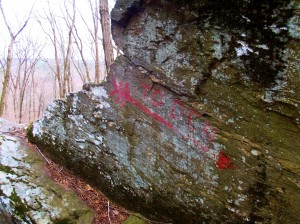 Recently we teamed up with members from the group known as Iron Miners. Like us they hunt down remarkable history and fantastic locations long forgotten in New England. What makes them unique, is that they pursue stories connected to mines lost in the forests across the northeast. Some of these tales are connected to important moments in the early history of America. We had such a great time working with them on the Lost cave of Monroe, we already have plans to team up with them on some fascinating projects in 2018.
Recently we teamed up with members from the group known as Iron Miners. Like us they hunt down remarkable history and fantastic locations long forgotten in New England. What makes them unique, is that they pursue stories connected to mines lost in the forests across the northeast. Some of these tales are connected to important moments in the early history of America. We had such a great time working with them on the Lost cave of Monroe, we already have plans to team up with them on some fascinating projects in 2018.
Over the years of hunting down mines, they have captured many of their adventure in short documentaries. We thought many of you would find them as interesting as we did, so we’ll be posting them on our blog. Later this year we’ll be posting new videos on the amazing stories we’re working on with them right now.
Posted in Archaeological, Cave, Geological, Historical, Subterranean and tagged connecticut, history, legend, mine, new england by Michael with 3 comments.

 Stories of lost gold mines have always been popular among prospectors and treasure hunters. It is often believed that an undiscovered motherlode is just waiting for some treasure hunter to find it using modern technology. Lost mines often recall tales like that of Lost Dutchman’s Mine, coded maps and the wild west. New England is the last place anyone would expect find a gold mine. But surprisingly the northeastern states did have a short-lived boom in prospecting and gold mining. So far, over 20 lost and forgotten gold mines have been found in New England (excluding all the places known for placer gold).
Stories of lost gold mines have always been popular among prospectors and treasure hunters. It is often believed that an undiscovered motherlode is just waiting for some treasure hunter to find it using modern technology. Lost mines often recall tales like that of Lost Dutchman’s Mine, coded maps and the wild west. New England is the last place anyone would expect find a gold mine. But surprisingly the northeastern states did have a short-lived boom in prospecting and gold mining. So far, over 20 lost and forgotten gold mines have been found in New England (excluding all the places known for placer gold).
With the stratospheric price of gold and popularity of the reality television show, Gold Rush, the interest in gold prospecting in New England has skyrocketed. Forgotten mines and minor gold rushes in the northeast are a terrific topic to explore. Since there are so many mines and location to discuss, they can’t all fit in one article. So, over the next year, look for a series of articles, each one spotlighting one of the six New England states, beginning with in Rhode Island. This southern New England state is known for its history, beaches, and food –not gold mines. Surprisingly the biggest little state still keeps a few secrets in the form of prospects and mines.
Posted in Geological, Historical, Subterranean by Michael with 16 comments.
 I’m often asked how we uncover these interesting places and history in New England. Often, I will stress the worth of libraries and lots of reading, but forget to mention the immense value of just talking to people. Many of our greatest discoveries come from a conversation with a friendly person we meet in our travels.
I’m often asked how we uncover these interesting places and history in New England. Often, I will stress the worth of libraries and lots of reading, but forget to mention the immense value of just talking to people. Many of our greatest discoveries come from a conversation with a friendly person we meet in our travels.
In fall of 2012, I was once again reminded that chatting with friends and family around you can also pay off. I was told that my father in-law Richard Gallo had a story about a long-forgotten cave in Cranston Rhode Island. Though I found it hard to believe I could have missed something like this, I was intrigued.
When I met with Richard, I immediately asked where the cave was located. Expecting to hear that it lay on a lonely hill in the western extremes of Cranston, I was surprised by what in his story revealed.
Posted in Cave, Geological, Historical, Subterranean and tagged Cave, cranston, deadman, kids, mine, pirate, ri, rite by Michael with no comments yet.

 In Cumbria, England, is Eden Valley, a quiet part of the UK with its traditional towns and pubs, beautiful hamlets and sandstone villages, some dating back to Viking times. A few miles north of the historic town of Penrith, is a small village called Little Salkeld. On the west side of the village is the Eden River. It was known to the Romans as the Itoun. This name derives from the Celtic word ituna, meaning water, or rushing. It winds its way north toward Carlisle.
In Cumbria, England, is Eden Valley, a quiet part of the UK with its traditional towns and pubs, beautiful hamlets and sandstone villages, some dating back to Viking times. A few miles north of the historic town of Penrith, is a small village called Little Salkeld. On the west side of the village is the Eden River. It was known to the Romans as the Itoun. This name derives from the Celtic word ituna, meaning water, or rushing. It winds its way north toward Carlisle.
The largest house in the village is the manor in Little Salkeld, confirmed by King Edward I. It is said to be the original home of the Salkeld family of landowners and Salkeld Hall built in the 16th century. The village has a vicarage with no church and Little Salkeld Watermill that was built in 1745 and is still operating. Little Salkeld is also known for Long Meg and Her Daughters, a Bronze Age stone circle consisting of 51 stones (of which 27 remain upright). The tallest stone is 3.7 meters high and stands outside the circle. It is made of local red sandstone, carved with a spiral, a cup and ring mark, and concentric circles. Poet William Wordsworth deemed them to be the country’s most notable relics after Stonehenge.
Posted in Cave, Geological, Historical, Subterranean by Tony T with no comments yet.
 In Rhode Island there is a rocky hill known as Queen’s Fort. It was an Indian fort that was occupied by Narragansett Indians that survived the battle in the Great Swamp, and chose not to leave RI. It lives on a hill covered with glacial erratics. With that natural feature alone, this was a fantastic place for a fort. Somewhere hidden in this rugged landscape is a cave know as Queen Quaiapens Chamber.
In Rhode Island there is a rocky hill known as Queen’s Fort. It was an Indian fort that was occupied by Narragansett Indians that survived the battle in the Great Swamp, and chose not to leave RI. It lives on a hill covered with glacial erratics. With that natural feature alone, this was a fantastic place for a fort. Somewhere hidden in this rugged landscape is a cave know as Queen Quaiapens Chamber.
Posted in Archaeological, Cave, Geological, Historical, Ruins, Subterranean by Michael with 4 comments.
 Penny Dreadful and I went out to find Leete’s Caves. We had previously tried few Saturdays ago. We were using direction and maps from a 1963 Yale publication, but due to development in the area the old access point was now private property. Fortunately we had already prepared for this and had plotted an alternate way to access the area. Unfortunately this required a longer hike through unbeaten forest, and crossing over a series of ridges. The incredible amount of large downed trees littering the forest made our hike to the caves like an obstacle course.
Penny Dreadful and I went out to find Leete’s Caves. We had previously tried few Saturdays ago. We were using direction and maps from a 1963 Yale publication, but due to development in the area the old access point was now private property. Fortunately we had already prepared for this and had plotted an alternate way to access the area. Unfortunately this required a longer hike through unbeaten forest, and crossing over a series of ridges. The incredible amount of large downed trees littering the forest made our hike to the caves like an obstacle course.
Posted in Cave, Geological, Subterranean by Michael with no comments yet.
 Almost a year ago we had found the counterfeiters den that had been lost for close to 100 years. We promised that we would share the full story behind the Den once our research was complete. Though the story is still not complete and there is much more research to be done, we felt we would share how much we have so far. We have withheld names and particular details of the story because we are currently working with members of the local government to protect it. We confirmed that the den is on private property and we are trying to arrange a conservation easement. For now, the den should be considered off limits. Soon we hope to meet with the land owners to begin discussions. We hope to develop a good relationship with them so that the den can be protected and possibly accessible in the future.
Almost a year ago we had found the counterfeiters den that had been lost for close to 100 years. We promised that we would share the full story behind the Den once our research was complete. Though the story is still not complete and there is much more research to be done, we felt we would share how much we have so far. We have withheld names and particular details of the story because we are currently working with members of the local government to protect it. We confirmed that the den is on private property and we are trying to arrange a conservation easement. For now, the den should be considered off limits. Soon we hope to meet with the land owners to begin discussions. We hope to develop a good relationship with them so that the den can be protected and possibly accessible in the future.
The History of “The Lost Counterfeiters Den”
In the fall of 2012, Ms Dreadful and I decided to turn our attention back to our long-term project of hunting down seldom-visited or long-forgotten caves in New England. We had accumulated a long list of caves by digging through our library of historic books and documents, and many visits to the local historical archives. This year we read about a cave that we had seen mentioned in the past. We had been involved in another project and neglected to make note of it. To avoid repeating the same mistake, we thought now was the best time to act.
At a rocky ridge on the south side of a ravine, deep in the forests of the New England, a band of counterfeiters were forging coins. Tradition says that at this same location there was a small cave they used to hide their tools and money. The cave was known by locals as Counterfeiters’ Den, and the last time it had been visited was the early 1920s. This cave was entered from above through a triangular opening that could be hidden by a rock slab that fit the opening. With little effort, it could be so well concealed in the forest landscape that only the men of this unscrupulous enterprise would ever be aware of its existence.
Posted in Cave, Geological, Historical, Subterranean by Michael with 27 comments.

 In Massachusetts there is a cave known as Mag’s or Margaret’s Cave. This cave is believed to be an important part of Rhode Island history. Lore also connects it to the nearby Devil’s Rock, claiming that two rocks near the cave are the devil and his wife turned to stone. It surprised me to find that this historically interesting cave appears to be a secret to most of the community.
In Massachusetts there is a cave known as Mag’s or Margaret’s Cave. This cave is believed to be an important part of Rhode Island history. Lore also connects it to the nearby Devil’s Rock, claiming that two rocks near the cave are the devil and his wife turned to stone. It surprised me to find that this historically interesting cave appears to be a secret to most of the community.
In October 1635, Roger Williams was tried by the General Court of Massachusetts and convicted of sedition and heresy. They felt that he was spreading “diverse, new, and dangerous opinions” and banished him from the state. His actual banishment was delayed due to the fact that he was ill, and winter was near. He was allowed the delay provided he ceased his agitation. Roger Williams did not cease, so in January 1636 the sheriff came to arrest him only to find he already had slipped away three days before, during a blizzard. He made the difficult journey of 105 miles from Salem to the head of Narragansett Bay during difficult winter weather. According to tradition, Roger Williams was very ill, and the local Wampanoags offered him shelter. They took him to the winter camp of their chief sachem, Massasoit. Here at what is now known as Margret’s Cave, Massasoit and another Indian known as Margaret cared for him for three month and nursed him back to health.
Posted in Cave, Geological, Historical by Michael with 4 comments.

A ledge of well foliated granite gneiss.
Squaw Rock and a nearby cave were mentioned briefly by Clay Perry in New England’s Buried Treasure. Information on the exact location of its caves’ and history of Squaw Rock was very limited. The most detailed record was found in Larned’s A Modern History of Windham County Connecticut, published in 1874. The book claims that Squaw Rock, “was a name supposed to have been given by early Indian Inhabitants.” It goes on to say that during the wars between tribes, the caves were used as a place to hide the “squaws and papooses.” Some local historians claim that it eventually became the location where the remnants of the tribe lived, until there was finally only a lone squaw for whom the cave was named.
The caves lie in a talus at the base of a nearly 75 foot high ledge that runs north for over 300 feet. In the 1700s it was a popular picnic spot for families. The locals gave the caves names like ‘The Devil’s Kitchen”, “Old Ladies’ Arm Chair”, and “Old Ladies’ Stove”. Other features of the talus were called “The Dancing Floor”, “Fiddler’s Stand” and “Pulpit Rock”. Larned speaks of a room with three passages. The first passage was from outside, the second lead to another chamber and a third “leads to an unknown distance.” She goes on to say, “It has been explored until the light carried went out, indicating danger if the parties went further.”
Posted in Cave, Geological, Historical, Subterranean by Michael with 4 comments.

An arrow showing the way to the Dragon’s Hole
New England has many Wildlife Management Areas. Though they highlight great sights, often there are long forgotten landmarks and geological curios hidden in their dark recesses. Over time the trails to them and mention on the maps fades away, and they are lost into history.
This past weekend we visited one of these landmarks hidden in the forests of Connecticut. We had first heard of this cave in a book about places to visit that was published in the 1930s by the state planning board. Since the 1700s it was referred to as Dragon’s Hole but eventually was also referred to as Devil’s Den. Though it was a popular feature in the 1800s, now it was once again absorbed back into the wild.
Devil’s Den was a common name used by colonial settlers concerning caves that gave the reason to suspect activity of a dark force. Dragon’s hole was said to be one of those cave. It was said that strange noise and lights would be seen coming from the grotto it lives within. Some believed that these tales were just folklore created by mothers trying to protect their children from the hazards of this wild terrain.
Posted in Cave, Geological, Historical, Subterranean by Michael with 1 comment.






